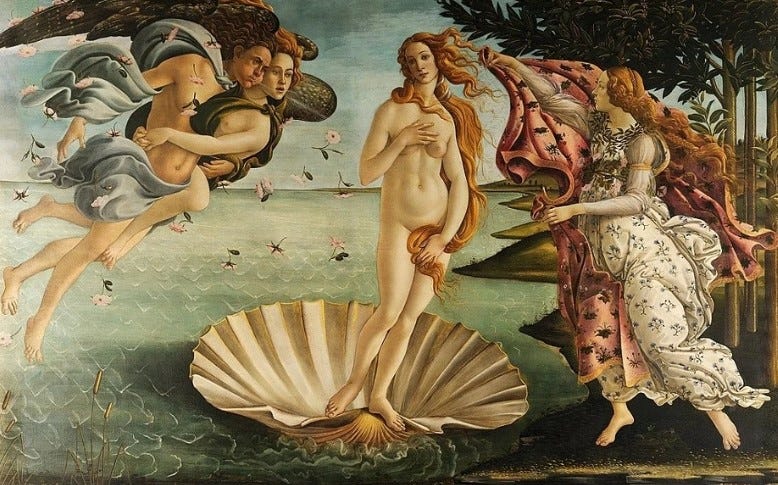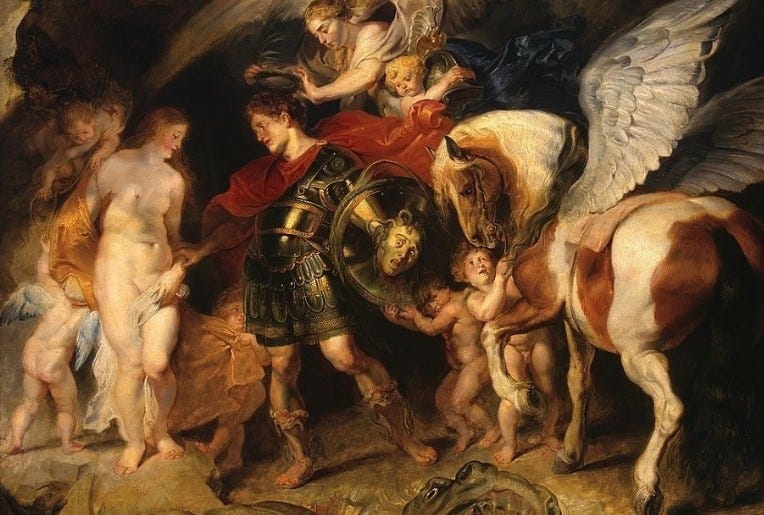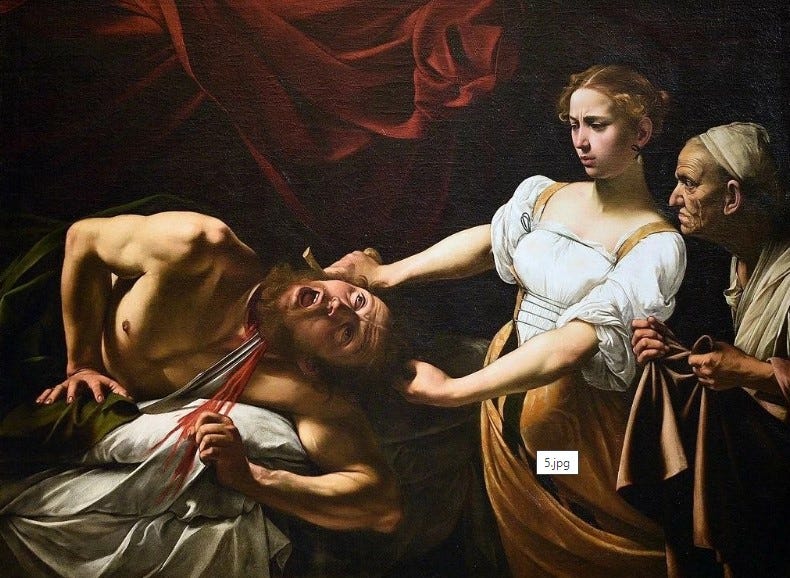FAMOUS ARTISTS PAINTINGS WITH MYTHOLOGICAL SUBJECTS
Mythological subjects in painting are full of vivid details. The images are conveyed as realistically as possible, and the plot is always rich and dynamic. And most importantly, these are multifaceted and deeply symbolic masterpieces. They will tell you more than any other work of art. Ancient myths have everything: feats and betrayals, love and hate, battles and divine feasts. A real action in fine art!
SANDRO BOTTICELLI, "THE BIRTH OF VENUS"
Sandro Botticelli was a great Italian painter of the Early Renaissance. He is considered one of the best illustrators of myths and creators of allegories. In Florence at the time of the artist, paintings on mythological themes were very popular. Ancient Greek and Roman myths were actively studied and considered from the point of view of history, not folk tales. Interest in mythology was spreading rapidly among the elite, so Botticelli was often commissioned to paint such pictures.
The myths of ancient Greece in the paintings of famous artists became a reflection of the past. "The Birth of Venus is perhaps one of the most famous works. It shows us the birth of the goddess of love and beauty: the girl appears in a shell, driven by the sea wind. On the left we see the wind god Zephyr and his beloved, but on the shore Venus is met by one of the graces. According to legend, Venus, also known as Aphrodite, was taken to Olympus after her birth, where she was loudly greeted by other gods.
Symbolism of the work
Like all the paintings of the great master, the canvas is full of symbols. For example, the orange tree stands for immortality, and the goddess of Spring, Ora Tallo, for pure heavenly love. The marshmallow stands for earthly, carnal love, which is emphasized by the embrace with the goddess of flowers.
It is believed that the painting was painted for a representative of the richest family in Florence, Lorenzo di Pierfrancesco de' Medici. Documents confirm that he owned the painting for a long time. But whether Botticelli actually painted for him remains a mystery.
PETER PAUL REUBENS, "PERSEUS RELEASES ANDROMEDA"
Rubens's paintings on mythological subjects are considered to be eternal classics and the greatest heritage of mankind. His handwriting is unmistakable! If you see plump angels and naked lush girls in a scene from Greek mythology on the canvas, it is definitely Rubens.
In Rubens's painting Perseus Releasing Andromeda, we see the birth of the feelings of the savior and the rescued. A truly romantic story! Let's start with the fact that Perseus and Andromeda are characters with very interesting origins.
The legend of Perseus' feat
Andromeda is a beauty who is forced to pay for the sins of her parents. To be more precise, her mother, who boasted of her beauty at the wrong time and place. Cassiopeia, Andromeda's mother, offended the Nereid goddesses with her pride. The latter complained to Poseidon and asked for revenge. The god summoned a terrible monster from the depths of the sea that threatened to destroy the entire city. Then the Oracle announced that the beast could be "appeased" by sacrificing Cassiopeia's daughter.
Andromeda was chained to a rock and given to the monster. It was in this form that she was seen by Perseus, the son of Danae and Zeus, who took possession of her in the form of golden rain. Perseus performed feats, just like Hercules. You probably know him from his winged sandals! In addition, it was Perseus who beheaded Medusa and then used her head to turn the monster Poseidon into stone.
Before the battle, Perseus carefully asked his father for permission to marry Andromeda. He gave his promise, keeping silent about the fact that his daughter already had a fiancé, his brother Phineas. The groom was not humiliated and showed up at the wedding with weapons. But Medusa's head was needed here, too: Perseus turned all the offenders to stone and lived with Andromeda for many happy years.
VIKTOR VASNETSOV, "IVAN THE TERRIBLE ON THE GRAY WOLF"
The painting is an illustration to the famous Russian fairy tale "Ivan the Terrible and the Gray Wolf". The artist painted this canvas when he was working on the painting of St. Volodymyr's Cathedral in Kyiv.
The fairy tale tells us about the adventures of Ivan the Terrible. Thanks to the gray wolf, Ivan finds the Firebird, Elena the Beautiful, and a faithful horse. He defeats his jealous brothers and the vile Koshchei, and soon becomes king. It is a wonderful tale of a brave hero and his adventures, imbued with the Russian spirit.
The most fabulous painting in Russian painting
The painting shows Ivan the Terrible and his beloved riding a wolf through a forest thicket to escape the chase. It is interesting that Victor Vasnetsov based the image of Helen of Troy on the portraits of Natalia Anatoliivna and Tatiana Anatoliivna Mamontov, who are cousins of the girl with the peaches.
Every detail of the canvas is amazing, and together they create a fabulous, mythical atmosphere. Elena the Beautiful is the Russian version of Venus, a model of beauty and innocence. Ivan the Terrible is an analog of Perseus or Hercules. The myths of different cultures do resonate, but each is filled with special and unique shades inherent in a particular society. This is a clear illustration of how art becomes a "file cabinet" of human beliefs, ideals, experiences, hopes and fears.
GUSTAVE MOREAU, "JUPITER AND SEMELE"
Gustave Moreau is a famous French painter whose painting is considered the best example of fine art of the late nineteenth century in Western Europe. His painting "Jupiter and Semele" is a truly grandiose work! This is one of several works that the artist did not have enough canvas to create. The master had to sew on strips of material to continue working.
The legend of Zeus and his beloved
The painting depicts one of the most tragic, strange, and at the same time touching stories in the mythology of ancient Greece. According to legend, Zeus's next mistress Semele, daughter of the king of Thebes and Harmony, fell victim to the jealous wife of the God. When the girl became pregnant by Zeus, Hera took on the appearance of an old woman and hired herself as a nurse for Semele. She persuaded the girl to ask Zeus to appear before her in his true form, knowing that this would mean her death.
Zeus refused to take on his true, divine form, but Semele was adamant. Then God transformed into a real giant amidst the roar of thunder and the shining of lightning. One of these lightning bolts hit the girl directly and killed her. Zeus decided to save the child: he took her out of Semele and sewed her up in his thigh. Soon, Dionysus, the future god of winemaking, was born from Zeus' body.
When Dionysus grew up and matured, he went down to the underworld of Hades and freed his mother. Since then, Semele has lived among the gods on Olympus and was called Fiona. In Thebes, a large temple was built in her honor and a cult of her name was active for a long time.
MICHELANGELO, "JUDITH AND OLOPHERNUS"
One of the most famous legends immortalized in Michelangelo's painting. According to the legend, the Babylonian army surrounded the city of Bethulia. The population was threatened with starvation and complete destruction, if not for the bravery of one young woman.
Judith, a beautiful and chaste widow, decided to make a sacrifice. She put on her best clothes, took a maid and went with her straight to the enemy camp to their commander, Olofern. Judith introduced herself as a prophetess and demanded to be presented to the commander-in-chief.
Judith was eloquent and seductive. She predicted victory for Olofern's army and told him that the Israelites had broken God's commandments and were doomed to die. The commander was mesmerized by the stranger's beauty and speeches and ordered her to stay in the camp. On the fourth day, Olofernus held a feast and expressed his desire to have Judith. But he got so drunk that he fell asleep in his tent. At that moment, Judith grabbed his sword and cut off Olophern's head. The girl and her maid returned to their hometown and had the head hung on the gate. The people attacked the camp, and the Babylonians discovered Olofern's body and fled.








